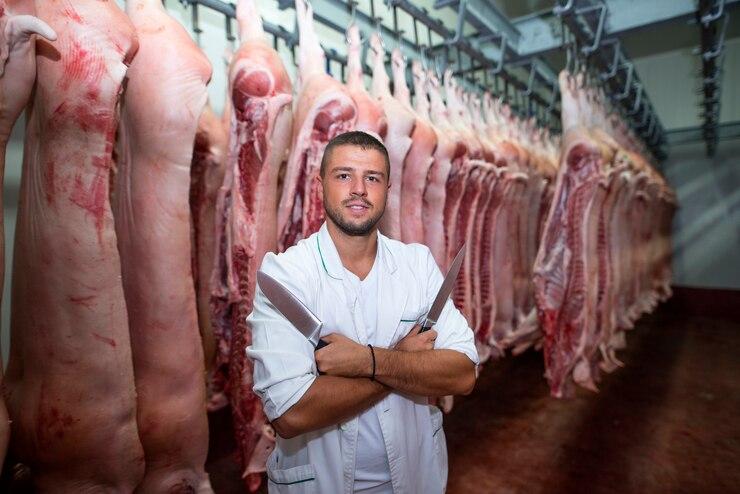Technology In The Slaughterhouse: Five Ways Life Is Made Better For Humans And Animals
5 Mins Read
Published on: 21 April 2022
Last Updated on: 14 June 2025

Whether you are a meat-eater or a dedicated vegan, the various animal and human issues that occur in slaughterhouses disturb us all.
But did you know? In recent years, the use of technology in slaughterhouses has really changed the meat industry. It has made the process more efficient and faster.
The introduction of robotics in the 1990s enabled the automation of various tasks within slaughterhouses, including handling and stunning animals.
Additionally, this has significantly reduced the time required to transport livestock to the slaughterhouse, allowing for faster and lower-cost meat production.
Further, technology has allowed slaughterhouses to operate more efficiently and maintain a higher level of quality control.
Can you guess the results? This has led to a decrease in the number of illnesses caused by meat, as well as an increase in the overall sales of meat. Amazing right!
Thus, here are some ways in which technology is helping to make lives better for humans and animals.
What Are The Issues Faced By Workers In Slaughterhouses?
Where animals are slaughtered, it is easy for us to assume what issues they face. Furthermore, it has been spoken about quite vividly.
Oh, but did you know? There are major challenges faced by the workers in slaughterhouses, and they are equally gruesome.
These issues were not taken into consideration for a long time, but the times are changing due to technological intervention.
1. Psychological Trauma
Working in a slaughterhouse can be very tough for workers and can negatively affect their mental health.
A study from 2016 found that slaughterhouse workers are more prone to experience clinical depression than people in general.
Other research shows that these workers also have higher rates of psychosis, anxiety, and serious mental distress when compared to the general population.
Some believe that slaughterhouse workers might suffer from high rates of PTSD, but others think a more accurate term is PITS, or perpetration-induced traumatic stress.
This condition occurs when someone regularly does violence or kills. Police officers and combat veterans often experience PITS.
Experts think that slaughterhouse workers may also be affected by this condition, but more research is needed to confirm it.
It’s not surprising that slaughterhouses have one of the highest employee turnover rates in the country.
2. Labor Abuses
Did you know? About 38 percent of slaughterhouse workers come from outside the U.S., and many are undocumented immigrants. Yes, you read it right!
This makes it easier for employers to break labor laws, often at the expense of the workers. In 2024, the Department of Labor fined a group of poultry processors.
This fine amounts to $5 million for various worker abuses, including failing to pay overtime and falsifying payroll records.
Furthermore, they are also employing illegal child labor and retaliating against workers who assisted federal investigators.
Child labor is common in slaughterhouses, and it is increasing. Between 2015 and 2022, the number of minors illegally working in slaughterhouses nearly quadrupled,
According to the Department of Labor. This was followed by a DOJ investigation that found children as young as 13 working at a slaughterhouse that supplied meat to Tyson and Perdue.
5 Technology Methods For Improved Human and Animal Lives
Every industry and factory has its operations systems. Science and technology are evolving. Along with science and technology, every industry is starting to adopt free technology to minimize human error.
Let’s see what slaughterhouse-five, technology makes your work fast and more productive are.
1. Automation
Automation in slaughterhouses has been around for a while now, and it is gradually becoming more popular.
The reason is quite justified. There are many benefits to automation, including its being time and cost-effective.
In addition, it can help to increase efficiency and safety in the slaughterhouse. Further, it is known to enhance meat quality and reduce the risk of human error.
Automation is continually improving the efficiency of the slaughterhouse. This is not only that you will require fewer human employees inside the slaughterhouse.
After the pandemic, we all agree with the point that fewer numbers of people gathering are always better.
2. Computerized Monitoring

Another technology method that helps to increase efficiency and safety is computerized monitoring.
The slaughterhouse workers can use this technology to see, specifically, what is happening at any given time.
It can also monitor the movement of animals and the flow of blood through a slaughterhouse, which can help them to avoid accidents. Computerized meat inspection systems can also help to ensure that each animal is inspected humanely.
Computerized monitoring is always better than human monitoring. As the computer operator can easily identify any malfunctions of the systems and call the technicians on time.
3. The Robot Depalletizer

A robotic depalletizer is used to remove the skin, fat, and other unwanted parts from carcasses before they are butchered.
The depalletizer can reduce the number of trips a butcher has to make to the slaughterhouse and speed up the process.
How do you think it helps? I’ll tell you. It helps to reduce labor costs and decrease contamination in the meat production process.
In addition, robot depalletizers are more efficient than human workers and can produce higher-quality meat.
4. Radiology

Slaughterhouse radiology is a technique that scientists use to study the internal organs of animals. This technique is supportive because it can help to prove that the butchers did not kill the animals brutally.
When the butchers are slaughtering the animals, it is possible to see the condition of an animal’s organs before and after being slaughtered through radiology.
It can help law enforcement agencies to prove that they did not mistreat the animals before they slaughtered them.
5. Deboning
Deboning includes removing the skin and meat from an animal carcass. It improves animal and human life in slaughterhouses.
Additionally, it also reduces the amount of stress on the animal, enhances the quality of the meat, and results in less waste.
As you can see, it is an essential step in the slaughterhouse. It allows for more efficient processing and ensures that the meat is of the correct quality.
Deboning also has many benefits for both human and animal life. Like, it leads to a cleaner product. The removal of blemishes and fat makes the meat more appetizing to consumers.
Are The Technologies In Slaughterhouses Making Progress?
All of these five slaughterhouse technologies are making revolutions in the meat production industry.
But every instrument requires proper maintenance. And you cannot skip the step of maintenance and monitoring processes.
If you install any automatic system in your factory, it is better to monitor its functions daily. And call the engineer before any accident can happen. Otherwise, you can also set up a separate maintenance department.



















Comments Are Closed For This Article